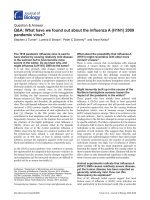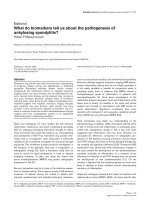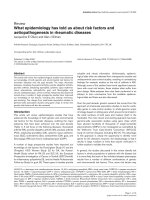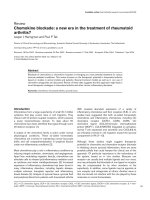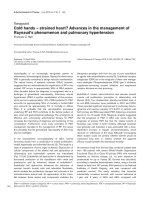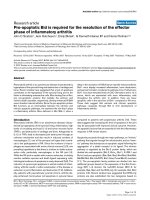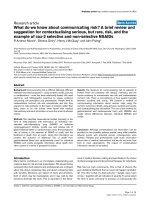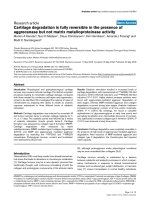Báo cáo y học: "What do biomarkers tell us about the pathogenesis of ankylosing spondylitis" ppsx
Bạn đang xem bản rút gọn của tài liệu. Xem và tải ngay bản đầy đủ của tài liệu tại đây (39.74 KB, 2 trang )
Page 1 of 2
(page number not for citation purposes)
Available online />Abstract
Biomarkers may provide information that promotes understanding
of prognosis, disease activity, and pathogenesis in ankylosing
spondylitis. Biomarkers reflecting disease activity (metallo-
proteinase-3) and inflammatory lesions on magnetic resonance
imaging predict new bone formation and are ameliorated by anti-
tumor necrosis factor therapy, yet this treatment may not prevent
new bone formation. Moreover, elevated levels of biomarkers
reflecting tissue repair (bone-specific alkaline phosphatase) post-
treatment together with magnetic resonance imaging indicates
such treatment may even promote repair through new bone
formation. Tumor necrosis factor regulation of Dickkopf-1 may con-
stitute a molecular brake that controls osteoblastogenesis through
wingless and bone morphogenetic proteins in an established
inflammatory lesion in ankylosing spondylitis.
Appel and colleagues [1] have studied the link between
inflammation, destruction, and repair in ankylosing spondylitis
(AS) by analyzing serological biomarkers thought to reflect
these processes. How does this advance our understanding
and assessment of AS? First, biomarkers may provide infor-
mation that is of prognostic value, particularly if sufficiently
validated to be considered surrogates for structural damage
end points. This constitutes a major priority for investigation in
AS because of the generally slow rate of progression of
radiographic change [2]. Such a biomarker could then be
used to enrich for rapid progressors in trials of disease
modifying therapies. To date, one study has shown that
serum metalloproteinase (MMP)3 may predict radiographic
progression in AS [3].
Second, biomarkers may be of value in the objective assess-
ment of disease activity. This is again a priority in AS because
measures of disease activity are limited to patient self-
reported questionnaires and standard laboratory measures,
such as acute phase reactants, lack sensitivity and specificity.
Moreover, although magnetic resonance imaging (MRI) demon-
strates inflammatory lesions that can be reliably quantified, it
is not readily available or feasible for prospective study. In
peripheral joints, there is evidence that MMP3 reflects a
histopathological grade of inflammation in patients with
spondylarthropathy [4]. Such direct investigation of the
relationship between biomarker levels and inflammation at the
tissue level is clearly not feasible in the spine and limited
analysis has focused on associations with MRI scores for
spinal inflammation. Significant correlations have been
reported with interleukin-6 and vasoactive epidermal growth
factor (VEGF) but not with serum MMP3 [5,6].
Third, biomarkers may clarify our understanding of the
pathophysiology of disease. Unlike rheumatoid arthritis, there
is still no formal proof that inflammation is necessarily asso-
ciated with radiographic change in AS. It has even been
suggested that inflammation and new bone formation are
uncoupled [7]. Moreover, comparison of radiographic pro-
gression in AS patients receiving anti-tumor necrosis factor
(anti-TNF) therapy with those receiving standard therapy has
not revealed any significant difference [8,9]. Prospective MRI
examination even shows that while inflammatory changes in
the spine predict the development of new syndesmophytes,
complete resolution of inflammation at a vertebral corner
following the institution of anti-TNF therapy does not prevent
the development of new syndesmophytes [10]. On the
contrary, it appears that new syndesmophytes are even more
likely to develop at those vertebral corners demonstrating
resolution of inflammation.
Appel and colleagues assessed the impact of treatment with
adalimumab on serum MMP3, VEGF, and bone specific alka-
Editorial
What do biomarkers tell us about the pathogenesis of
ankylosing spondylitis?
Walter P Maksymowych
Department of Medicine, University of Alberta, Edmonton, Alberta T6G 2S2 Canada
Corresponding author: Walter P Maksymowych,
See related research article by Appel et al., />Published: 7 January 2009 Arthritis Research & Therapy 2009, 11:101 (doi:10.1186/ar2565)
This article is online at />© 2009 BioMed Central Ltd
AS = ankylosing spondylitis; BALP = bone specific alkaline phosphatase; BMP, bone morphogenetic protein; DKK = Dickkopf; MMP = metallopro-
teinase; MRI = magnetic resonance imaging; TNF = tumor necrosis factor; VEGF = vasoactive epidermal growth factor.
Page 2 of 2
(page number not for citation purposes)
Arthritis Research & Therapy Vol 11 No 1 Maksymowych
line phosphatase (BALP) over a period of 2 years and
compared this to biomarker levels in patients followed in an
observational cohort, GESPIC. While no change in bio-
markers was evident in GESPIC patients over 2 years, a
significant reduction in MMP3 and VEGF was observed that
correlated with a change in C reactive protein in adalimumab
treated patients. Conversely, a significant increase in BALP
was noted that correlated inversely with a change in MMP3.
These observations support the findings from several other
studies with anti-TNF agents [5,6] and are consistent with
observations from MRI studies where resolution of inflammation
with anti-TNF therapy is followed by new bone formation [10].
How might these findings be explained at a molecular level?
Recent work has shown that TNF alpha stimulates expression
of Dickkopf (DKK)-1, a major regulator of joint remodeling
through its suppression of signaling by wingless proteins
(Wnt), which are key mediators of osteoblastogenesis [11].
Moreover, regulation of Wnt signaling by DKK-1 and -2 regu-
lates osteoblast differentiation induced by bone morpho-
genetic protein (BMP)-2 [12]. So once inflammation is
allowed to resolve through pharmacological suppression of
TNF alpha, this may allow signaling through Wnt and other
growth factors such as BMP-2 to induce new bone formation.
TNF alpha may be viewed as a molecular brake on new bone
formation acting through DKK-1, but this then begs the
question as to whether anti-TNF therapy might in fact
accelerate new bone formation in patients with AS and why
this was not observed in clinical trials. It is important to
address this in the context of the histopathological evolution
of an inflammatory lesion in the spine. Early lesions have
features of synovial and subchondral marrow inflammation
that is followed by erosion of subchondral bone, formation of
woven bone and metaplastic cartilage, and finally synthesis of
endochondral bone by osteoblasts. In established AS, each
patient is likely to have several spinal lesions at different
stages of evolution and it may be possible that very early
lesions resolve with anti-TNF therapy prior to the induction of
reparative changes while accelerated reparation is observed
with anti-TNF therapy in the more mature inflammatory lesions
where reparation is already underway. The overall outcome
for the individual patient is then little changed at the level of
the entire spine. Lack of impact of adalimumab on BALP in
pre-radiographic disease is consistent with this hypothesis.
This raises the concept of a window of opportunity for
disease modification in AS using anti-TNF therapy. New trials
of anti-TNF therapies in patients presenting early in their
disease course prior to the appearance of significant repair in
the spine are now a high priority.
Competing interests
WPM has received honoraria and/or research grants from
Amgen/Wyeth, Schering Canada, Abbott Labs.
References
1. Appel H, Janssen L, Listing J, Heydrich R, Rudwaleit M, Sieper J:
Serum levels of biomarkers of bone and cartilage destruction
and new bone formation in different cohorts of patients with
axial spondyloarthritis with and without tumor necrosis
factor-alpha blocker treatment. Arthritis Res Ther 2008, 10:
R125.
2. Wanders AJ, Landewé RB, Spoorenberg A, Dougados M, van der
Linden S, Mielants H, van der Tempel H, van der Heijde DM:
What is the most appropriate radiologic scoring method for
ankylosing spondylitis? A comparison of the available
methods based on the Outcome Measures in Rheumatology
Clinical Trials filter. Arthritis Rheum 2004, 50:2622-2632.
3. Maksymowych WP, Landewé R, Conner-Spady B, Dougados M,
Mielants H, van der Tempel H, Poole AR, Wang N, van der Heijde
D: Serum matrix metalloproteinase 3 is an independent pre-
dictor of structural damage progression in patients with anky-
losing spondylitis. Arthritis Rheum 2007, 56:1846-1853.
4. Vandooren B, Kruithof E, Yu DT, Rihl M, Gu J, De Rycke L, Van
Den Bosch F, Veys EM, De Keyser F, Baeten D: Involvement of
matrix metalloproteinases and their inhibitors in peripheral
synovitis and down-regulation by tumor necrosis factor alpha
blockade in spondylarthropathy. Arthritis Rheum 2004, 50:
2942-2953.
5. Visvanathan S, Wagner C, Marini JC, Baker D, Gathany T, Han J,
van der Heijde D, Braun J: Inflammatory biomarkers, disease
activity and spinal disease measures in patients with ankylos-
ing spondylitis after treatment with infliximab. Ann Rheum Dis
2008, 67:511-517.
6. Maksymowych WP, Rahman P, Shojania K, Olszynski WP,
Thomson GTD, Ballal S, Wong RL, Inman RD: Beneficial effects
of Adalimumab on biomarkers reflecting structural damage in
patients with ankylosing spondylitis. J Rheumatol 2008, 35:
2030-2037.
7. Lories RJ, Derese I, de Bari C, Luyten FP: Evidence for uncou-
pling of inflammation and joint remodeling in a mouse model
of spondylarthritis. Arthritis Rheum 2007, 56:489-497.
8. van der Heijde D, Landewé R, Baraliakos X, Houben H, van
Tubergen A, Williamson P, Xu W, Baker D, Goldstein N, Braun J;
Ankylosing Spondylitis Study for the Evaluation of Recombinant
Infliximab Therapy Study Group: Radiographic findings follow-
ing two years of infliximab therapy in patients with ankylosing
spondylitis. Arthritis Rheum 2008, 58:3063-3070.
9. van der Heijde D, Landewé R, Einstein S, Ory P, Vosse D, Ni L,
Lin SL, Tsuji W, Davis JC Jr: Radiographic progression of anky-
losing spondylitis after up to two years of treatment with
etanercept. Arthritis Rheum 2008, 58:1324-1331.
10. Maksymowych WP, Chiowchanwisawakit P, Clare T, Pedersen S,
Ostergaard M, Lambert RGW: Inflammatory lesions of the
spine on MRI predict the development of new syndesmo-
phytes in ankylosing spondylitis: Evidence for coupling
between inflammation and new bone formation. Arthritis
Rheum, in press.
11. Diarra D, Stolina M, Polzer K, Zwerina J, Ominsky MS, Dwyer D,
Korb A, Smolen J, Hoffmann M, Scheinecker C, van der Heide D,
Landewe R, Lacey D, Richards WG, Schett G: Dickkopf-1 is a
master regulator of joint remodeling. Nat Med 2007, 13:156-
163.
12. Fujita K, Janz S: Attenuation of WNT signaling by DKK-1 and -2
regulates BMP2-induced osteoblast differentiation and expres-
sion of OPG, RANKL and M-CSF. Mol Cancer 2007, 6:71.

